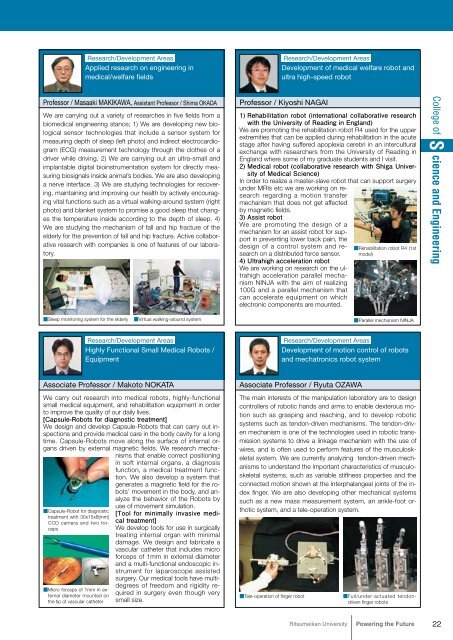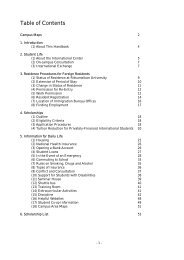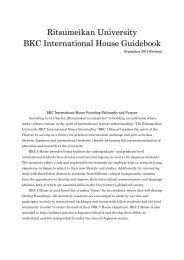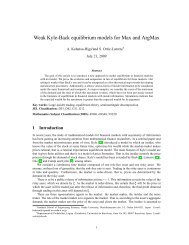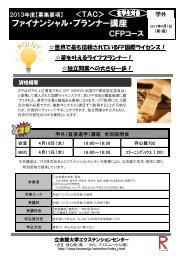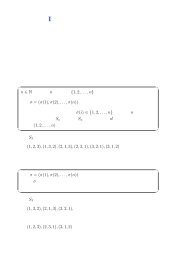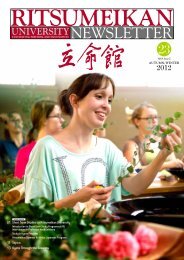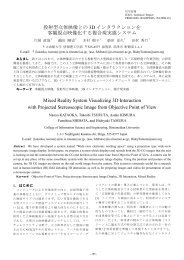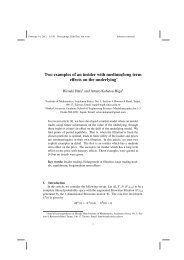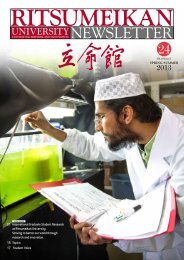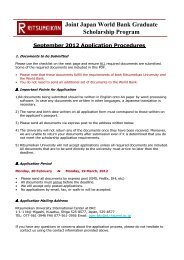Powering the Future - 立命館大学
Powering the Future - 立命館大学
Powering the Future - 立命館大学
You also want an ePaper? Increase the reach of your titles
YUMPU automatically turns print PDFs into web optimized ePapers that Google loves.
Research/Development Areas<br />
Applied research on engineering in<br />
medical/welfare fields<br />
Research/Development Areas<br />
Development of medical welfare robot and<br />
ultra high-speed robot<br />
Professor / Masaaki MAKIKAWA, Assistant Professor / Shima OKADA<br />
We are carrying out a variety of researches in five fields from a<br />
biomedical engineering stance; 1) We are developing new biological<br />
sensor technologies that include a sensor system for<br />
measuring depth of sleep (left photo) and indirect electrocardiogram<br />
(ECG) measurement technology through <strong>the</strong> clo<strong>the</strong>s of a<br />
driver while driving. 2) We are carrying out an ultra-small and<br />
implantable digital bioinstrumentation system for directly measuring<br />
biosignals inside animal’s bodies. We are also developing<br />
a nerve interface. 3) We are studying technologies for recovering,<br />
maintaining and improving our health by actively encouraging<br />
vital functions such as a virtual walking-around system (right<br />
photo) and blanket system to promise a good sleep that changes<br />
<strong>the</strong> temperature inside according to <strong>the</strong> depth of sleep. 4)<br />
We are studying <strong>the</strong> mechanism of fall and hip fracture of <strong>the</strong><br />
elderly for <strong>the</strong> prevention of fall and hip fracture. Active collaborative<br />
research with companies is one of features of our laboratory.<br />
Professor / Kiyoshi NAGAI<br />
1) Rehabilitation robot (international collaborative research<br />
with <strong>the</strong> University of Reading in England)<br />
We are promoting <strong>the</strong> rehabilitation robot R4 used for <strong>the</strong> upper<br />
extremities that can be applied during rehabilitation in <strong>the</strong> acute<br />
stage after having suffered apoplexia cerebri in an intercultural<br />
exchange with researchers from <strong>the</strong> University of Reading in<br />
England where some of my graduate students and I visit.<br />
2) Medical robot (collaborative research with Shiga University<br />
of Medical Science)<br />
In order to realize a master-slave robot that can support surgery<br />
under MRIs etc we are working on research<br />
regarding a motion transfer<br />
mechanism that does not get affected<br />
by magnetic fields.<br />
3) Assist robot<br />
We are promoting <strong>the</strong> design of a<br />
mechanism for an assist robot for support<br />
in preventing lower back pain, <strong>the</strong><br />
design of a control system and research<br />
on a distributed force sensor.<br />
4) Ultrahigh acceleration robot<br />
We are working on research on <strong>the</strong> ultrahigh<br />
acceleration parallel mechanism<br />
NINJA with <strong>the</strong> aim of realizing<br />
100G and a parallel mechanism that<br />
can accelerate equipment on which<br />
electronic components are mounted.<br />
■Rehabilitation robot R4 (1st<br />
model)<br />
College of S cience and Engineering<br />
■Sleep monitoring system for <strong>the</strong> elderly<br />
■Virtual walking-around system<br />
■Parallel mechanism NINJA<br />
Research/Development Areas<br />
Highly Functional Small Medical Robots /<br />
Equipment<br />
Research/Development Areas<br />
Development of motion control of robots<br />
and mechatronics robot system<br />
Associate Professor / Makoto NOKATA<br />
We carry out research into medical robots, highly-functional<br />
small medical equipment, and rehabilitation equipment in order<br />
to improve <strong>the</strong> quality of our daily lives.<br />
[Capsule-Robots for diagnostic treatment]<br />
We design and develop Capsule-Robots that can carry out inspections<br />
and provide medical care in <strong>the</strong> body cavity for a long<br />
time. Capsule-Robots move along <strong>the</strong> surface of internal organs<br />
driven by external magnetic fields. We research mechanisms<br />
that enable correct positioning<br />
in soft internal organs, a diagnosis<br />
function, a medical treatment function.<br />
We also develop a system that<br />
generates a magnetic field for <strong>the</strong> robots’<br />
movement in <strong>the</strong> body, and analyze<br />
<strong>the</strong> behavior of <strong>the</strong> Robots by<br />
■Capsule-Robot for diagnostic<br />
treatment with 30x15x8[mm]<br />
CCD camera and two forceps<br />
■Micro forceps of 1mm in external<br />
diameter mounted on<br />
<strong>the</strong> tip of vascular ca<strong>the</strong>ter<br />
use of movement simulation.<br />
[Tool for minimally invasive medical<br />
treatment]<br />
We develop tools for use in surgically<br />
treating internal organ with minimal<br />
damage. We design and fabricate a<br />
vascular ca<strong>the</strong>ter that includes micro<br />
forceps of 1mm in external diameter<br />
and a multi-functional endoscopic instrument<br />
for laparoscope assisted<br />
surgery. Our medical tools have multidegrees<br />
of freedom and rigidity required<br />
in surgery even though very<br />
small size.<br />
Associate Professor / Ryuta OZAWA<br />
The main interests of <strong>the</strong> manipulation laboratory are to design<br />
controllers of robotic hands and arms to enable dexterous motion<br />
such as grasping and reaching, and to develop robotic<br />
systems such as tendon-driven mechanisms. The tendon-driven<br />
mechanism is one of <strong>the</strong> technologies used in robotic transmission<br />
systems to drive a linkage mechanism with <strong>the</strong> use of<br />
wires, and is often used to perform features of <strong>the</strong> musculoskeletal<br />
system. We are currently analyzing tendon-driven mechanisms<br />
to understand <strong>the</strong> important characteristics of musculoskeletal<br />
systems, such as variable stiffness properties and <strong>the</strong><br />
connected motion shown at <strong>the</strong> interphalangeal joints of <strong>the</strong> index<br />
finger. We are also developing o<strong>the</strong>r mechanical systems<br />
such as a new mass measurement system, an ankle-foot orthotic<br />
system, and a tele-operation system.<br />
■Tele-operation of finger robot<br />
■Full/under-actuated tendondriven<br />
finger robots<br />
Ritsumeikan University<br />
<strong>Powering</strong> <strong>the</strong> <strong>Future</strong><br />
22


